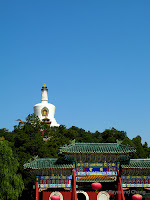In the last article, we have talked about some very famous attractions in Beijing.But in this chapter,maybe you are not familiar with the two tourist attractions which are magnificent while with great history background.Let's show you the Beihai Park and Lama Temple in detail.
Chapter Six
--Beihai Park & Lama Temple
Someone may say that the real Beijing is in the streets. However, the answer is partly right. The magnificent places in Beijing are also undivided parts of the culture of old Beijing. Do you explore for places as elegant in nature while with great history background? Sometimes, those most famous places can have perfect combinations of these two. Beihai Park and Lama Temple are the two outstanding among them.
As a lead, Beihai Park is well-known for its natural elegance and the historical greatness of Lama Temple proves its status.
Beihai Park
Beijing’s most elegant park is built around the Bei hai, the north lake in Beijing. It is one of the oldest, largest and best-preserved ancient imperial gardens in China located in the city center.
The charms of Beihai Park include pavilions, gardens and a stunning Tibetan-style pagoda.—It is not only a classic combination of the grandiosity of the northern gardens and the refinement of the southern gardens in China, but also a perfect integration of magnificent imperial palaces and solemn religious constructions.
1. Circular City
Circular City is at the southwestern corner of Beihai Park. The city wall stands about 4.6 meters high and has a circumference of 276 meters. Among the various places to visit in the Circular City including halls, towers and pavilions, the most important construction is the Chengguang Hall which holds the extremely precious white jade statue of Buddha introduced from Burma at the end of Qing Dynasty.
2. White Dagoba
 |
| White Dagoba |
3. Nine-Dragon Screen
 |
| Nine-Dragon Screen |
There are nine huge coiling dragons on each side of the screen and big or small dragons in different postures decorating the two ends and the eaves, making a surprising total of 635 dragons.
4. Five-Dragon Pavilions
To the southwest of the Nine-Dragon Screen lies the Five-Dragon Pavilions - five connected pavilions with spires and pointed upswept eaves. From a distance, they appear together like a huge dragon.
There are many exquisite carvings and paintings on the girders and pillars of the pavilions which make the Five-Dragon Pavilions a delightful place for the royal members in ancient China to relax and appreciate the natural beauty.
Lama Temple
Lama Temple is the largest and best-preserved lamasery in Beijing. The dimension of the temple is magnificent. Decorated with delicate scrolls and massive icons, its buildings are a hybird of Tibetan, Mongolian and Han architectural styles.
The evergreen pine and cypress trees make for a peaceful and secluded environment. The back structural layout is composed of a cluster of buildings, halls and pavilions intermingled with each other. Upturned eaves and ridges are beautifully interwoven, forming a picturesque architecture.
The 5 worship halls in Lama Temple are in a row. As a result of the ancient architecture, every element of the temple is entirely symmetrical, with main halls on a north-south axis and wing halls on both sides. The front structural layout of the temple is bright and spacious.
1. Hall of Heavenly Kings
 |
| Hall of Heavenly Kings |
2. Hall of Harmony
It’s filled with prayer wheels and Buddhas of the Past, Present and Future, flanked by statues of 18 arhats, Buddhist "saints"who have reached Nirvana but have returned to help others.
3. Hall of Eternal Blessing
 |
| Hall of Eternal Blessing |
4. Hall of the Wheel of Law
It’s the study place for the monks and pray in the presence of a 12m-tall bronze statue of Tsong Khapa, the founder of the Yellow Hat sect. Behind this statue is a sculpture of a hill on which stand 500 arhats made of gold, silver, copper, iron and tin.
5. Pavilion of 10,000 Blessings
 |
| Pavilion of 10,000 Blessings |
After all these vividly description of Beihai Park and Lama Temple, do you have a heartbeat and eagerness to go to these two places? –Just follow your heart to experience the natural elegance and historical greatness of Beijing to get real enjoyments.

No comments:
Post a Comment
Thanks for your comment and welcome to China!